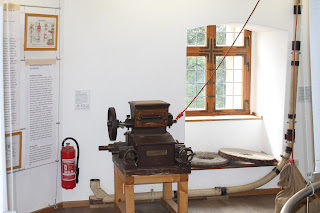Bereits Friedrich Wilhelm I., der Soldatenkönig gäbe den Auftrag zum Bau einer Windmühle. So entstand 1736-38 eine Bockwindmühle, die auf dem Bock in Windrichtung gedreht wurde. Als diese baufällig wurde, gab Friedrich II. seinem Architekt Cornelius van der Bosch Auftrag und Geld eine neue Mühle zu bauen, denn die Mühle von Potsdam war durch eine Legende über die Landesgrenzen hinaus berühmt (www.Potsdam-wiki.de/index.php/Der_Mueller_von_Sanssouci).
Somit entstand eine Galeriewindmühle nach holländischem Vorbild, die später auch Teil einer von Friedrich Wilhelm IV. geplanten Prachtstraße sein sollte. Die Märzrevolution und ein Mangel an finanziellen Mitteln verhinderte die Ausführung dieses Bauvorhabens.
Die wechselvolle Geschichte der historischen Mühle von Sanssouci fand ein vorläufiges Ende mit ihrer Zerstörung in der letzten Kriegstagen im April 1945.
Von der Mühle blieb nur der Rumpf erhalten und im Jahr 1983 begann der Wiederaufbau, der sich mit Unterbrechungen bis 1995 hinzog. Seitdem wird die Mühle wieder betrieben und der freundliche Müller ist gern bereit Fragen zu seiner Arbeit und der Funktionsweise seines Arbeitsplatzes zu beantworten. Und natürlich kann man auch das Mehl, das hier gemahlen wird und das Brot, das daraus gebacken wird erwerben.
Already King Friedrich Wilhelm I, The Soldier King commisioned the building of a wind mill. And so a post mill was erected in 1736-38, wich was turned on it's post in the direction the wind from. When this one went old and ruined, Friedrich II. told his architect Cornelius van der Bosch to Build a new one with the king's own money, because the wind mill of Sanssouci was famous, even abroad (en.wikipedia.org/wiki/Historic_mill_of_Sanssouci).
So was build a gallery wind mill like the mills in Holland. Later it should be part of an avenue, but the March Revolution and the lack of money made that those plans could not come true.
The historie of the Mill of Sanssouci came to a temporary end in the last days of World War II in April 1945, when it was destroyed.
Only the stone base left from the mill and in 1983 the reconstruction began and came to an end in 1995 and since that time the mill is working again. The friendly miller is always ready to answer questions about his work and the way the mill works.
And of course one can get flour wich was grinded there or bread baked of the flour.










Keine Kommentare:
Kommentar veröffentlichen